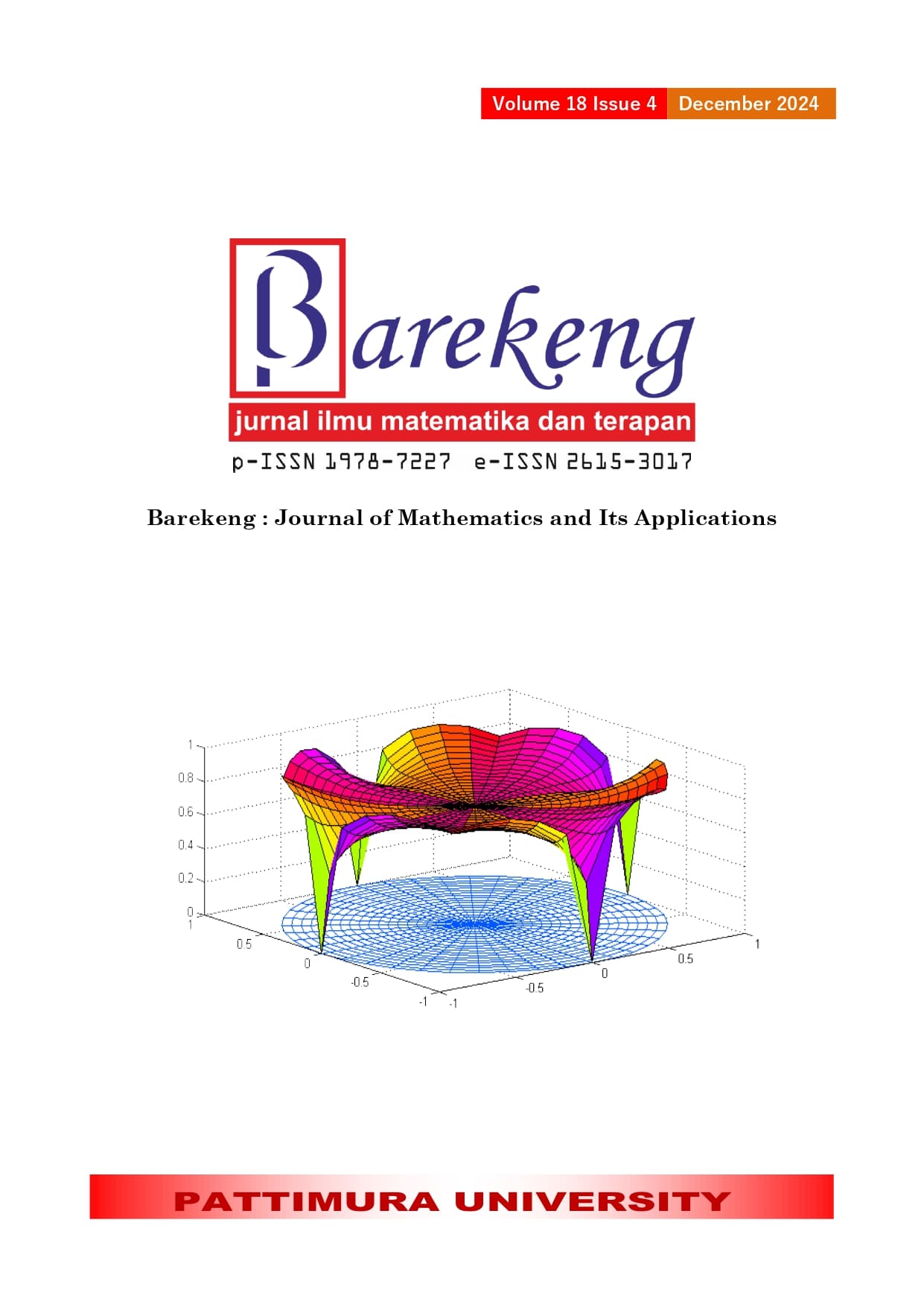SACR EPIDEMIC MODEL FOR THE SPREAD OF HEPATITIS B DISEASE BY CONSIDERING VERTICAL TRANSMISSION
Abstract
Hepatitis B is an infectious disease that causes inflammation of the liver due to infection with the Hepatitis B virus. Hepatitis B is divided into two phases: the acute phase and the chronic phase. Hepatitis B virus (HBV) can be prevented through vaccination and treatment of susceptible and infected individuals. The spread of the virus can be modeled using mathematical modeling of epidemics. In this study, the model used consists of four classes, namely vulnerable individuals (S), acute individuals (A), chronic individuals (C), and recovered individuals (R). The purpose of this study is to explain the formation of the Hepatitis B disease epidemic model, analyze the stability of the model, perform simulations, and conduct parameter sensitivity analysis on the basic reproductive number. The result of this study is the construction of an epidemic model of the spread of hepatitis B disease in the form of a SACR model. This model takes into account the transmission that occurs not only through interactions between susceptible individuals and chronic individuals but also through the birth process, which occurs in chronic subpopulations because babies born can be chronically infected (vertical transmission from mother to baby). The model produces two equilibrium points, the disease-free equilibrium and the endemic equilibrium. Both points were analyzed for stability using the linearization method and were found to be asymptotically stable. Furthermore, the model simulation was carried out using the fourth-order Runge-Kutta method and sensitivity analysis of the basic reproduction number. From the results obtained, it can be concluded that the spread of hepatitis B disease can be minimized by reducing contact between susceptible and chronic individuals, increasing treatment of chronic individuals, and increasing the number of vaccinated individuals in susceptible populations.
Downloads
References
Siswanto, Epidemiologi Penyakit Hepatitis. Samarinda, 2020.
A. Din, Y. Li, and Q. Liu, “Viral dynamics and control of hepatitis B virus (HBV) using an epidemic model,” Alexandria Eng. J., vol. 59, no. 2, pp. 667–679, 2020.
S. H. A, “Masa Inkubasi Hepatitis B,” 2022. https://ciputrahospital.com/masa-inkubasi-hepatitis-b/ (accessed Jul. 27, 2023).
Annisa, “Virus Hepatitis B di Indonesia dan risiko penularan terhadap mahasiswa kedokteran,” Anat. Med. J. Fak. Kedokt., vol. 2, no. 2, pp. 66–72, 2019, [Online]. Available: http://jurnal.umsu.ac.id/index.php/AMJ
F. Sulistya and Bayu, “Kemenkes Catat 50.744 Ibu Hamil Terinfeksi Hepatitis B pada 2022 Kemenkes Catat 50.744 Ibu Hamil Terinfeksi Hepatitis B pada 2022,” 2023. https://dataindonesia.id/ragam/detail/kemenkes-catat-50744-ibu-hamil-terinfeksi-hepatitis-b-pada-2022 (accessed Jul. 28, 2023).
S. L. Ross, Differential Equation, Third. New Delhi: John Wiley & Sons, New Delhi, 2004.
H. Mehlhorn, Encyclopedia of Parasitology, 3rd ed. New York: Springer Science, 2008.
J. Giesecke, Modern Infectious Dissease Epidemiology, Third Edit. New York, 2017.
S. Zhao, Z. Xu, and Y. Lu, “A mathematical model of hepatitis B virus transmission and its application for vaccination strategy in China,” Int. J. Epidemiol., vol. 29, no. 4, pp. 744–752, 2000.
S. Ullah, M. A. Khan, and J. F. Gómez-Aguilar, “Mathematical formulation of hepatitis B virus with optimal control analysis,” John Wiley Sons, vol. 40, no. 3, pp. 1–16, 2019, doi: 10.1002/oca.2493.
T. Khan, Z. Ullah, N. Ali, and G. Zaman, “Modeling and control of the hepatitis B virus spreading using an epidemic model,” Chaos, Solitons &Fractals, 2019, [Online]. Available: https://www.sciencedirect.com/science/article/pii/S0960077919301420
A. H. Hasmani, B. Safi, and A. Das, “A Mathematical Model and Study of Viral Hepatitis among Population in Afghanistan,” Commun. Biomath. Sci., vol. 6, no. 1, pp. 36–50, 2023, doi: 10.5614/cbms.2023.6.1.4.
Munir, “Metode Numerik,” C. V. ANDI OFFSEET, p. 82, 2003.
P. Van Den Driessche and J. Watmough, “Reproduction numbers and sub-threshold endemic equilibria for compartmental models of disease transmission,” Math. Biosci., vol. 180, no. 1–2, pp. 29–48, 2005, doi: 10.1016/S0025-5564(02)00108-6.
H. Anton and C. Rorres, Aljabar Linear Elementer, 11th ed. Jakarta: Erlangga, Jakarta, 2014.
J. W. Cain and A. M. Reynolds, Ordinary and Partial Differential Equations. NC-ND, Virginia, 2010.
H. Hasnawati, R. Ratianingsih, and J. W. Puspita, “Analisis Kestabilan Model Matematika Pada Penyebaran Kanker Serviks Menggunakan Kriteria Routh-Hurwitz,” J. Ilm. Mat. Dan Terap., vol. 14, no. 1, pp. 120–127, 2017, doi: 10.22487/2540766x.2017.v14.i1.8360.
W. E. Boyce, D. H. Trahan, and R. C. DiPrima, Elementary Differential Equations and Boundary Value Problems., 11th ed. United States: John Wiley & Sons, 2017. doi: 10.2307/2320609.
N. Chitnis, J. M. Hyman, and J. M. Cushing, “Determining important parameters in the spread of malaria through the sensitivity analysis of a mathematical model,” Bull. Math. Biol., vol. 70, no. 5, pp. 1272–1296, 2008, doi: 10.1007/s11538-008-9299-0.
S. Edward and N. Nyerere, “A Mathematical Model for the Dynamics of Cholera with Control Measures,” vol. 4, no. 2, pp. 53–63, 2015, doi: 10.11648/j.acm.20150402.14.
M. A. Karim and Y. Yulida, “Analisis Kestabilan dan Sensitivitas pada Model Matematika SEIRD dari Penyebaran Covid-19: Studi Kasus di Kalimantan Selatan,” Media Bina Ilm., vol. 16, no. 5, pp. 7003–7012, 2021.
L. Perko, Differential Equations and Dynamical Systems, Third Edit. New York: Springer-Verlag, 2013.
Copyright (c) 2024 Yuni Yulida, Agung Setyo Wiranto, Faisal Faisal, Muhammad Ahsar Karim, Oni Soesanto

This work is licensed under a Creative Commons Attribution-ShareAlike 4.0 International License.
Authors who publish with this Journal agree to the following terms:
- Author retain copyright and grant the journal right of first publication with the work simultaneously licensed under a creative commons attribution license that allow others to share the work within an acknowledgement of the work’s authorship and initial publication of this journal.
- Authors are able to enter into separate, additional contractual arrangement for the non-exclusive distribution of the journal’s published version of the work (e.g. acknowledgement of its initial publication in this journal).
- Authors are permitted and encouraged to post their work online (e.g. in institutional repositories or on their websites) prior to and during the submission process, as it can lead to productive exchanges, as well as earlier and greater citation of published works.






1.gif)



